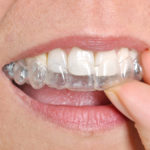17 Aug Invisalign vs. Traditional Braces
 If you have heard of Invisalign, the fact that this teeth-straightening method is clear and discreet likely appeals to you. Invisalign is quite different from traditional orthodontia yet can deliver virtually the same results by aligning teeth to healthier positions. Like traditional braces, Invisalign can improve a patient’s occlusion as well as correct spacing issues, such as overlapping and gaps. Our dentist offers Invisalign to teenagers and adults who desire a straighter, healthier smile. Following is some helpful information that compares the differences between traditional braces and Invisalign.
If you have heard of Invisalign, the fact that this teeth-straightening method is clear and discreet likely appeals to you. Invisalign is quite different from traditional orthodontia yet can deliver virtually the same results by aligning teeth to healthier positions. Like traditional braces, Invisalign can improve a patient’s occlusion as well as correct spacing issues, such as overlapping and gaps. Our dentist offers Invisalign to teenagers and adults who desire a straighter, healthier smile. Following is some helpful information that compares the differences between traditional braces and Invisalign.
Traditional braces consist of fixed oral appliances made from metal and plastic. For example, brackets are bonded to teeth to support other appliances like wires and ligatures that apply consistent pressure to the teeth to move them to straighter positions over time. In some cases, external oral appliances may need to be worn, such as headgear, to guide tooth movement of a newly emerging adult tooth.
While adults may wear traditional braces, children undergoing tooth transition (the period where baby teeth are slowly replaced by adult teeth) most commonly wear this form of orthodontic treatment. Traditional braces are very effective at correcting all orthodontic issues, but they are very conspicuous and for this reason, many adults turn to more discreet forms of treatment: Invisalign.
Invisalign was specifically developed to meet the needs of adults who required orthodontic treatment but wanted to improve their appearance in a less noticeable way. Using the same principles as traditional braces, Invisalign applies gentle, yet constant, pressure to the teeth to move them into straighter positions over time. The difference, however, is in the type of materials used in both teeth-straightening oral appliances.
Invisalign utilizes sets of clear plastics called aligners, which are worn in succession to straighten teeth over the course of treatment. Every two weeks, patients will wear a new, tighter set of aligners. Unlike traditional braces, aligners are removable. This means that patients will take out their aligners to eat and clean their teeth. Since aligners are removable and made of comfortable plastics, they will not irritate or cut into soft oral tissues.
If you are interested in improving your smile with Invisalign, call our office today to reserve a consultation with our dentist.
